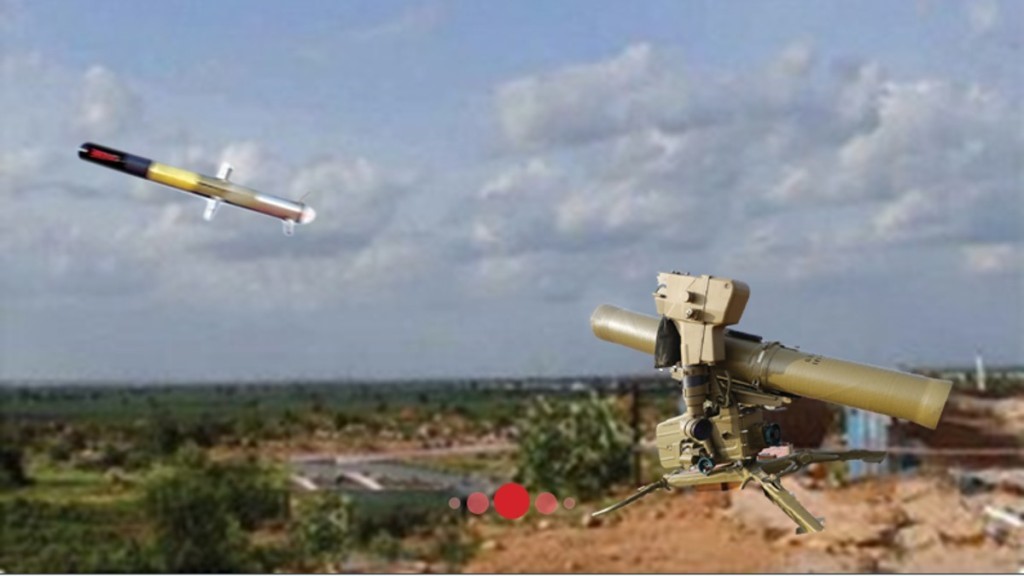Description

Disclaimer: Copyright infringement not intended.
Context
- Bharat Dynamics (BDL) has successfully conducted a field firing test of its latest 3rd generation man-portable Anti Tank Guided Missile (ATGM), Amogha-III.
About Amogha III
- Amogha-III is a third generation fire-and-forget Anti-Tank Guided Missile designed and developed by the in – house R&D Division of BDL.
- This indigenous missile has been developed under Integrated Guided Missile Development Programme (IGMDP).
- The whole missile system comes with a command launch unit (CLU), remote operation capability and a tripod.
- Amogha-III ATGM boasts a fire-and-forget capability, requiring no external intervention following launch.
- Developed by BDL’s Research and Development Division, the missile also features a dual-mode IIR Seeker with a range of 200 to 2500 meters.
- Assisted by the Defence Research and Development Organisation (DRDO), Amogha-III showcases a tandem warhead, consisting of two separate explosive charges that are detonated in sequence.
- The first charge, known as the precursor charge, penetrates the target’s armour, creating a hole for the second charge, the main charge, to detonate inside, maximizing damage inflicted on the target.
- The use of a tandem warhead significantly enhances the missile’s ability to defeat heavily armoured targets.
- The missile can be fired in lock-on-before launch (LOBL) mode and its anti-armour tandem warhead can penetrate in excess of 650 mm beyond Explosive Reactive Armour (ERA).
|
FEATURES
- Range: 200 – 2500 m.
- Attack mode: Top / direct attack
- Man-portable.
- Tandem warhead with penetration in excess of 650 mm beyond Explosive Reactive Armor (ERA).
- Dual Mode Imaging Infra-Red (IIR) Seeker.
- Aerodynamic and Thrust Vector Control.
- Smokeless, Signature-free Propulsion System.
- Soft launch.
|
About ATGM
- An anti-tank guided missile (ATGM), anti-tank missile, anti-tank guided weapon (ATGW) or anti-armor guided weapon is a guided missile primarily designed to hit and destroy heavily armored military vehicles.
- ATGMs range in size from shoulder-launched weapons, which can be transported by a single soldier, to larger tripod-mounted weapons, which require a squad or team to transport and fire, to vehicle and aircraft mounted missile systems.
.jpeg)
Background
- Earlier man-portable anti-tank weapons like anti-tank rifles and magnetic anti-tank mines, generally had very short range, sometimes on the order of metres or tens of metres.
- Rocket-propelled high-explosive anti-tank (HEAT) systems appeared in World War II and extended range to the order of hundreds of metres, but accuracy was low and hitting targets at these ranges was largely a matter of luck.
- It was the combination of rocket propulsion and remote wire guidance that made the ATGM much more effective than these earlier weapons.
- The introduction of semi-automatic guidance in the 1960s further improved the performance of ATGMs.
ATGMs in India
Laser guided ATGM: indigenously developed by DRDO, it employs a tandem High Explosive Anti-Tank (HEAT) warhead to defeat Explosive Reactive Armour (ERA) protected armoured vehicles.
Helina: maximum range of seven kilometers and has been designed and developed for integration on the weaponized version of the Advanced Light Helicopter.
Nag: third-generation fire-and-forget missile developed for mechanized formations to engage heavily fortified enemy tanks.
Man-Portable ATGM: range of 2.5 kilometers, with fire-and-forget and top attack capabilities for infantry use.
Smart Stand-off Anti-Tank Missile (SANT): is being developed for launch from the Mi-35 Helicopter.
About Bharat Dynamics Limited
- It is one of India's manufacturers of ammunitions and missile systems.
- It was founded in 1970 in Hyderabad.
- BDL has three manufacturing units, located at Kanchanbagh, Hyderabad; Bhanur, Medak district, and Visakhapatnam, Andhra Pradesh.

About IGMDP
- The Integrated Guided Missile Development Programme was an Indian Ministry of Defence programme for the research and development of the comprehensive range of missiles.
- The programme was managed by the Defence Research and Development Organisation (DRDO) and Ordnance Factories Board.
- The project started in 1982–83 under the leadership of Abdul Kalam who oversaw its ending in 2008 after these strategic missiles were successfully developed.
- APJ Abdul Kalam started multiple projects simultaneously to develop the following types of Indian Guided Missiles missiles.
- Short Range Surface to Surface Missile (SSM) ‘Prithvi’
- Long Range Surface to Surface Missile (SSM) ‘Agni’
- Medium Range Surface to Air Missile (SAM) ‘Akash’
- Short Range Surface to Air Missile (SAM) ‘Trishul’
- Anti-tank Guided Missile (ATGM) ‘Nag’
|
PRACTICE QUESTION
Q) India’s Integrated Guided Missile Development Programme has tasted success as far as the development of strategic missiles is concerned. Discuss. (250 words)
|

https://www.financialexpress.com/business/defence-indigenous-anti-tank-guided-missile-amogha-iii-tested-successfully-know-about-it-3027152/
















